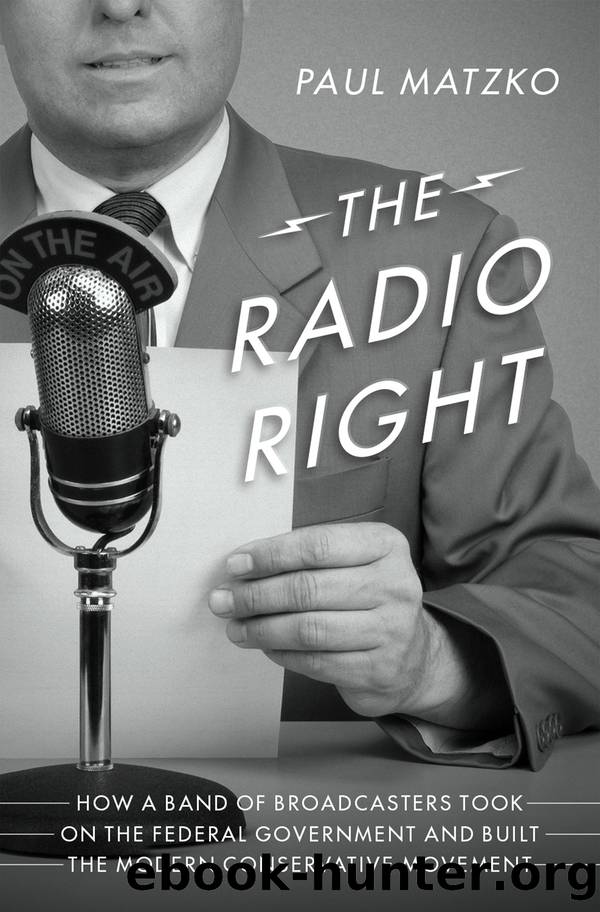The Radio Right by Paul Matzko

Author:Paul Matzko [Matzko, Paul]
Language: eng
Format: epub
Published: 2020-08-15T00:00:00+00:00
6
Outsourcing Censorship
How the National Council of Churches Silenced Fundamentalist Broadcasters
The Democratic National Committee (DNC) relinquished leadership of the counterâRadio Right campaign in 1965, but the infrastructure of the campaign remained in place. The tactical use of the Fairness Doctrine to extract free airtime and to intimidate radio stations had been proven to work twice over, first with the Citizens Committee for a Nuclear Test Ban and then with the DNCâs summer of 1964 campaign. The Fairness Doctrine itself had been refined and expanded, and was even then receiving legal validation in a series of court cases. All that was needed for the counter-Right campaign to continue was an organization that could replace the DNC, a role that the National Council of Churches (NCC) was happy to fill. During the late 1960s the NCC would greatly ratchet up the pressure on radio stations airing conservative broadcasting. Two such stations, WLBT in Jackson, Mississippi, and WXUR in Media, Pennsylvania, fought back and lost their station licenses for their pains; hundreds more stations preemptively dropped conservative programs altogether.
Over the past decade, scholars have been paying closer attention to the history of mainline Protestantism, a loosely defined collection of denominations which, by the mid-twentieth century, claimed more adherents than any other religious tradition in America. Mainline clergy tended to be more theologically and politically liberal than their counterparts in evangelical churches (or, for that matter, than their own parishioners).1 When discussing the mainline during the 1960s, the new historiography emphasizes the prophetic role played by the NCC and other ecumenical organizations as they protested the Vietnam War, advocated for nuclear disarmament, and campaigned for civil rights legislation even as mainline pews slowly but steadily emptied of parishioners. This sympathetic view of ecumenical Protestantism can spill over into effusive declarations like that of theologian Gary Dorrien, that the mainline âserved as guardians of Americaâs moral culture,â âpreserved the idea that the USA was a nation with the soul of a church,â and âhelped to liberalize American society.â2 This glossy depiction of ecumenical Protestantism elides over the willingness of mainline leaders to fight hard (and even dirty) in defense of their claim to represent the soul of America. At times, the mainlineâs defense of liberalism could be profoundly illiberal.3
Although the NCC remained the largest religious organization in America in the 1960sâits forty-five million members was more than the Catholic Churchâs forty-two millionâit had peaked.4 Nobody in the NCCâs leadership could have imagined how rapid its decline in membership would be over the next half century, but they did worry at the time about the many parishioners and even entire churches that were leaving the association under the influence of conservative, religious broadcasters. It is no accident that it was in this moment, as the NCC felt a growing sense of anxiety about its status in American society, that the term âmainlineâ was first defined in its modern sense as a shorthand for liberal Protestantism. The term evoked the wealthy, well-connected suburbs along the Main Line railroad
Download
This site does not store any files on its server. We only index and link to content provided by other sites. Please contact the content providers to delete copyright contents if any and email us, we'll remove relevant links or contents immediately.
| Automotive | Engineering |
| Transportation |
Whiskies Galore by Ian Buxton(41801)
Introduction to Aircraft Design (Cambridge Aerospace Series) by John P. Fielding(33045)
Small Unmanned Fixed-wing Aircraft Design by Andrew J. Keane Andras Sobester James P. Scanlan & András Sóbester & James P. Scanlan(32731)
Craft Beer for the Homebrewer by Michael Agnew(18123)
Turbulence by E. J. Noyes(7920)
The Complete Stick Figure Physics Tutorials by Allen Sarah(7291)
Kaplan MCAT General Chemistry Review by Kaplan(6851)
The Thirst by Nesbo Jo(6809)
Bad Blood by John Carreyrou(6519)
Modelling of Convective Heat and Mass Transfer in Rotating Flows by Igor V. Shevchuk(6376)
Learning SQL by Alan Beaulieu(6192)
Weapons of Math Destruction by Cathy O'Neil(6116)
Man-made Catastrophes and Risk Information Concealment by Dmitry Chernov & Didier Sornette(5900)
Digital Minimalism by Cal Newport;(5633)
Life 3.0: Being Human in the Age of Artificial Intelligence by Tegmark Max(5447)
iGen by Jean M. Twenge(5352)
Secrets of Antigravity Propulsion: Tesla, UFOs, and Classified Aerospace Technology by Ph.D. Paul A. Laviolette(5299)
Design of Trajectory Optimization Approach for Space Maneuver Vehicle Skip Entry Problems by Runqi Chai & Al Savvaris & Antonios Tsourdos & Senchun Chai(4996)
Electronic Devices & Circuits by Jacob Millman & Christos C. Halkias(4889)
